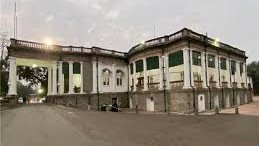Indore (Madhya Pradesh): The row over the renaming of 200-year-old Residency Kothi in Madhya Pradesh’s Indore took a new turn on Monday as descendants of Saadat Khan, a martyr of the 1857 mutiny, sought that the historic structure be named after him.
Khan, leading local revolutionaries, attacked Residency Kothi. The British later executed him in the historic building, and his memorial was also built there.
The Mayor in Council (MIC), chaired by Mayor Pushyamitra Bhargava on October 18, decided that Residency Kothi would be renamed Shivaji Kothi, officials said.
After that, “Punyashlok”, a social organisation, sought the structure be named after Devi Ahilyabai, the ruler of the erstwhile Holkar dynasty of Indore.
According to officials, members of the organisation also put a banner, “Devi Ahilya Bai Kothi”, outside the main gate of this building on October 21.
Talking to PTI on Monday, Saadat Khan’s descendant, Rizwan Khan, said, “We fully honour Chhatrapati Shivaji Maharaj and Devi Ahilyabai, but whenever one speaks about Residency Kothi, Saadat Khan’s martyrdom is also mentioned.” “Hence, we want the building to be named after Saadat Khan,” he added.
He recalled that his family and descendants of other revolutionaries have been demanding the renaming for years.
Shaheen Awais Bahadur, a member of the erstwhile royal family of Banda in Uttar Pradesh, said one of her ancestors helped in Saadat Khan’s burial.
Bahadur, president of the women’s committee of “Hindavi Swarajya Mahasangh”, said, “We want at least one public place in Indore to be named after Saadat Khan for the coming generations to remember him.” Mayor Bhargava said, “The British ran their affairs from the Residency Kothi. To erase the bolt of slavery, we have named it Shivaji Kothi so that people draw inspiration from courage and valour.” Asked about the demand to name the building after Saadat Khan, he said, “Khan’s memorial is already there. If there is a need to name a place in the city after him, we will do it. We are determined to take the message of every martyr of the freedom struggle to the coming generations.’ Historian Zafar Ansari said the East India Company started the construction of Residency Kothi in 1820, and British officers ran the princely states of entire central India from there.
‘Revolutionary Saadat Khan, with armed rebels, attacked Residency Kothi on July 1, 1857, demolished its entrance and took control of the building. The revolutionaries took down the flag of the East India Company from the structure and replaced it with the flag of the then Holkar princely state,’ he said.
Ansari said Saadat Khan was arrested in 1874 from the then Rajputana (present-day Rajasthan). He was tried by the British and sentenced to death.
He was hanged from a tree in the Residency Kothi complex on October 1, 1874, he said.
(Except for the headline, this article has not been edited by FPJ’s editorial team and is auto-generated from an agency feed.)

